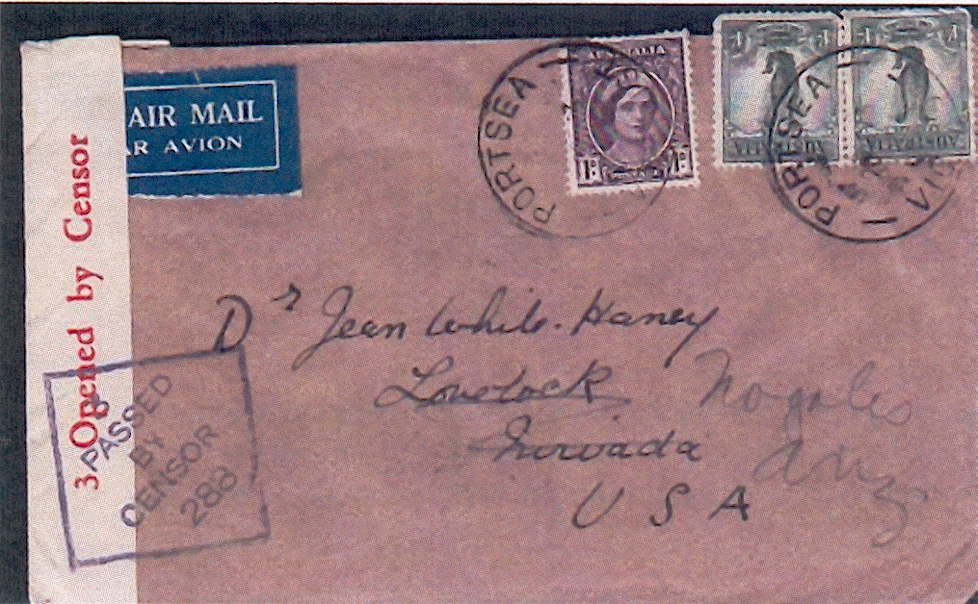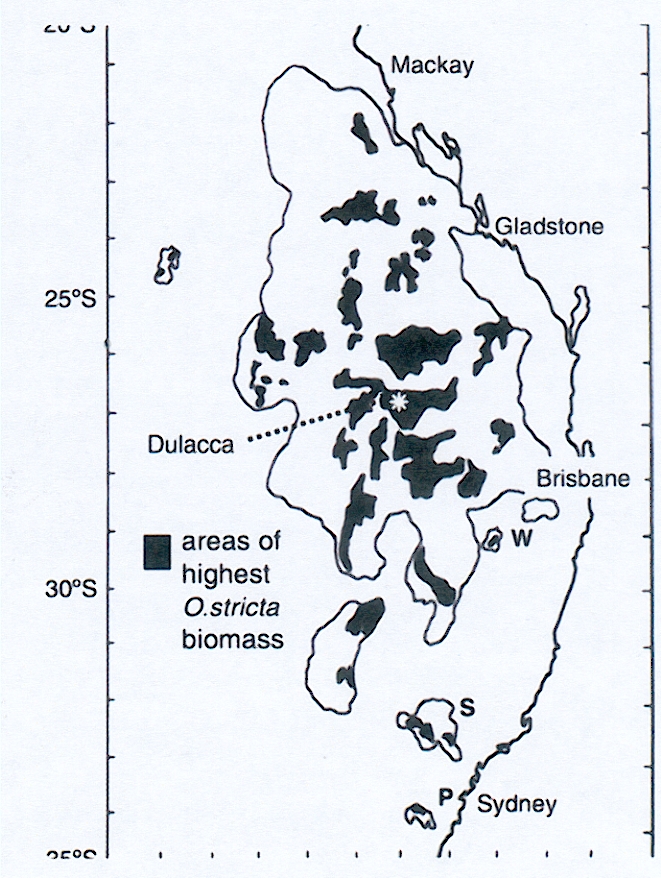Four censored covers from Victoria were sent in 1943 to the United States, all with the red censor label and with the Passed By Censor purple handstamp. The first was sent from PORTSEA/ VIC cancel on the brown-purple 1d QE II and a pair of the small green ‘Lyre Bird’ stamps to Dr. Jean White-Haney at Lovelock Nevada, and readdressed to Arizona (Figure 1).

The second was sent from ST. KILDA/ 16 NO 43/ VIC to Dr Jean Haney White to Nogales, Arizona with a vertical strip of three of the ½d ‘Kangaroo’ and a single red 2d KGVI stamp (Figure 2).
The third was sent with a boxed MELBOURNE/ 15 NOV/ 1943/ VICTORIA roller cancel to Dr. Jean Haney White to California and redirected to Nogales, Arizona with two orange ½d ‘Kangaroo’ and a red 2½d KGVI stamps (Figure 3).
The fourth was addressed to Mrs V.W. Haney (the initials of her husband) and sent to California with a re-direct to Arizona from Melbourne on 15 September with the 1d brown-purple QE II stamp and a red 2½d KGVI stamp (Figure 4).
Rose Ethel Janet White-Haney, botanist, was born on 11 March 1877 at the Melbourne Observatory, South Yarra, seventh of eight children of English-born parents Edward John White, astronomer, and his wife Sarah Susanna Catharine. ‘Jean’ was educated privately until the age of 15, and then at Presbyterian Ladies’ College, and the University of Melbourne (B.Sc., 1904; M.Sc., 1906; D.Sc., 1909). She taught science at the Presbyterian Ladies College, Melbourne. After sharing (in 1906) the MacBain research scholarship in biology she was awarded, two years later, a Victorian government scholarship. Under the direction of Alfred Ewart she investigated the enzymes and latent life of seeds. The work was published (1910) in Proceedings of the Royal Society of London. She was elected (1908) a member of the Royal Society of Victoria, and in 1908-11 her research papers on bitter pit in apples and the formation of red wood in conifers appeared in its proceedings.
In 1912 the Queensland Board of Advice on Prickly Pear Destruction appointed White officer-in-charge of its experimental station at Dulacca, about 261 miles (420 km) west of Brisbane. She arrived at the undeveloped site in July, and immediately began studies on the control of Dulacca pear (Opuntia inermis), working in a tent until the laboratory building was completed several months later. During the next four years she conducted more than ten thousand chemical poisoning experiments and tested fungal cultures imported from overseas by Thomas Johnston and Henry Tryon. She also demonstrated the efficacy of the cochineal insect Coccus indicus (Green) as a controlling agent for Opuntia monacantha, a species of prickly pear that was widespread in North Queensland.
On 22 February 1915 at Holy Advent Church of England, Malvern, Melbourne, White married Victor William Haney, an American-born agricultural chemist. Her marriage did not affect her employment, but the station at Dulacca closed in 1916. In her final report she concluded that arsenic pentoxide was superior to other chemicals in destroying the pear, but that, given the cost of poisoning, the only real solution lay in discovering ‘some parasitic insects or organisms capable of bringing about the destruction of the different species of prickly-pear as completely as the Coccus indicus (Green) has done for the monacantha species in North Queensland’. Eventually the moth Cactoblastis cactorum, introduced to Queensland in 1926, controlled prickly pear.
White-Haney lived for a short time in Western Queensland before moving to Brisbane. She was a founding member (1919) of the Lyceum Club (secretary 1922-24, president 1924-26), a committee-member (1925-26) of the Queensland Bush Book Club, and a fund-raiser (1924-29) for Women’s College, University of Queensland. She attended the 1926 Pan-Pacific Science Congress in Tokyo, and two years later was employed on a short-term contract by the Council for Scientific and Industrial Research to study the pasture weeds Noogoora and Bathurst burrs. This was her last scientific project. In 1930 she joined her husband who had returned to the United States of America some years earlier. She visited Australia in 1936. Survived by her husband and their two sons, she died on 21 October 1953 at Camarillo, California, and was buried in Inglewood Park cemetery. A picture of Jane at one of her graduations at the University of Melbourne is seen in Figure 5.
Between the two World Wars, the eradication of the prickly pear slowly grew to assume high priority in eastern Australia. The Commonwealth Prickly Pear Board (recommended by Jean White-Haney in 1916, and established in December 1919) was the first scientific project funded jointly by the Commonwealth and State governments (New South Wales and Queensland). Early chemical campaigns were based on White-Haney’s experiments. An example of a cartoonist’s rendition of public concern for the prickly pear and a map of the most affected areas in eastern Australia are seen in Figures 6 and 7.

Most of the text was taken from the Australian Dictionary of Biography.